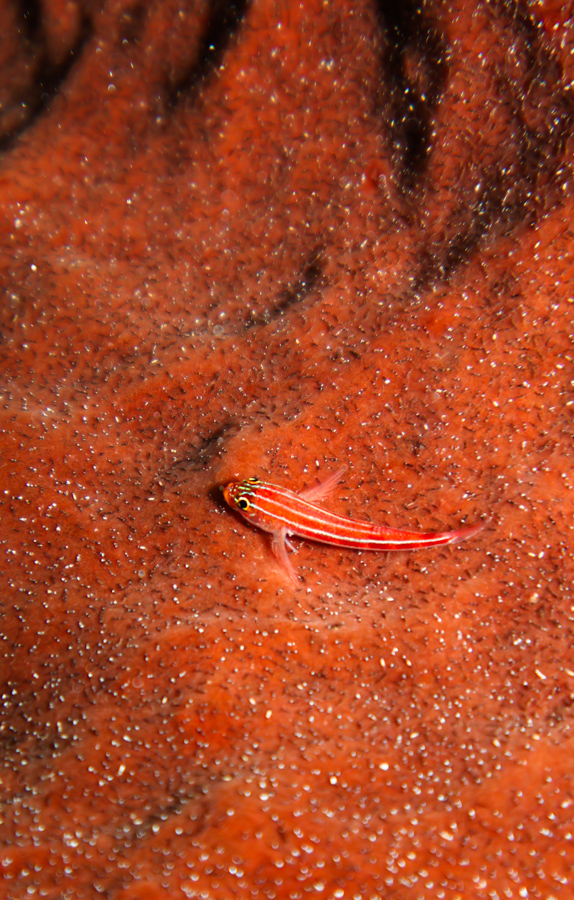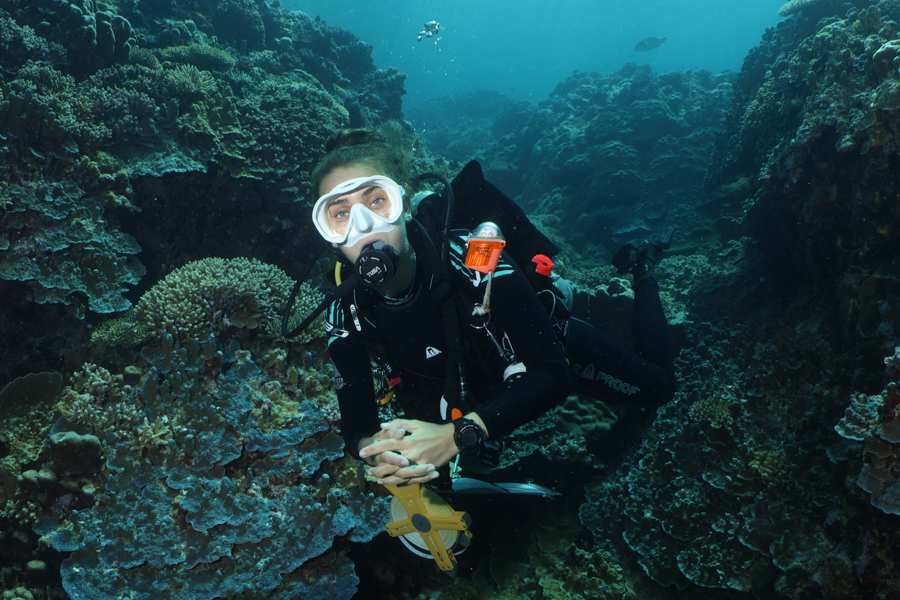“Weights, mask, dive Computer, transect reel, slate, GPS tracker, camera… that’s everything”.
“All good to go?” Kirsty asks,
“Yup!” I reply, as we plunge into the water off the back of the catamaran.
As we descend into the water column, I can’t quite believe what we're seeing. 30m visibility allows us to see in every direction, revealing thousands upon thousands of shimmering glassfish. Swimming through them was like gliding through a shifting, silver cloud as they hovered above the reef. We look at each other with wide eyes, laughing through our regulators. Photos will have to wait though; we’ve got data to collect! I grab my transect reel and begin rolling it out across the reef.
This was one of the most special dives from my recent scholarship experience with Reef Life Survey, travelling to remote reefs 300 km off the coast of northern Australia. The crew of four; Prof. Graham Edgar, Anna Edgar, Kirsty Whitman, and myself, surveyed a variety of tropical reef sites all the way from Gulmerrogin/Darwin to Marapikurrinya/Port Hedland, including Ashmore Reef, Scott Reef, and the infamous Rowley Shoals. In 3 ½ weeks we sailed over 1000nm, which was just one of the legs of Graham's lap of Australia aboard his sailing catamaran Melita. I completed 39 dives, and as a team we surveyed over 75 sites! We also established several new sites that haven’t previously been surveyed using RLS methods. We were remarkably blessed with conditions while out on the water this trip. Often while motoring along in the tender, we'd be pinching ourselves, marvelling at the glass out day where the horizon and the ocean blended into one. The water was so still you could almost do a survey from the surface, watching the fish flit around on the reef below. “You know the weather isn’t always like this, right?” skipper Gedgar kept reminding me.

Kicking off this leg of Melita's lap of Australia, dolphins accompanied us on the bow as we headed off the coast of Darwin. We were en route to survey a remote chain of deep-water oceanic shoals. It was too rough to dive the first day, but the second day we were able to get in the water and explore some new sites. The shoals were 18-20m deep, so we had to be quick with our surveys. One site had incredible structure, but almost no live coral, looking like it had been hit by a powerful bleaching event years ago, with no local recruitment to support recovery. I had to wonder what those reefs would have looked like 20 years ago.
Cartier Island, Ashmore Reef & Scott Reef
On our way out to Ashmore Reef, we were lucky to survey within the Pink Zone at Cartier Island. The next three days would be spent surveying a variety of sites within the lagoon at Ashmore, as well as a day of surveying at Seringapatam Atoll where we were greeted by some friendly sea snakes. We were so far out into the Timor Sea that every few days we would have friendly check-ins from border force planes and vessels based at Ashmore. Kirsty, a long-time RLSer, also got to explore some new sites; shoals off the North-eastern tip of WA! There was lots of current, and beautiful sea whips swirled in the surge.
We spent 2-3 days at Scott Reef, marveling at the glass out days. Unlike Ashmore Reef, Scott is not protected. After one of our dives, we came up surrounded by about 6 Indonesian fishing canoes. They had been watching us in the water, probably wondering what we were doing rolling up our transect reels and carrying around clipboards. Given its proximity to Indonesia in the Timor Sea, Scott Reef is a popular fishing destination. After that, we were punching through headwinds for two nights to reach the Rowley Shoals.

Rowley Shoals
The Rowley Shoals were a real treat. Kirsty and I did the deepest transect of the trip at 22m at Cod Hole; it was deep and dark, with lots of vibrant soft corals and even a group of three massive dogtooth tuna (Gymnosarda unicolor) cruising through.
Then we were off to Clerke Reef; a remote coral atoll within the Rowley Shoals Marine Park. The first couple of days brought mucky lagoon diving with 5m vis, but eventually the conditions fined up for us and we were blessed with 35m vis in both the shallows and the depths, making for some beautiful surveys. Imagine vibrant blue staghorn meadows in the shallows, and incredible biomass on the deep slopes, with big schools of pelagics swirling around the thermocline.
Bedout Island
We stopped in at Bedout Island en route to Port Hedland. Here we did some of our most challenging surveys of the trip, met with surge, ripping current, and 4m visibility all in shallow water. On one dive I even dodged a stonefish laying out my transect line! It was great to test out my new survey skills in some tough conditions. Coming in to port at Marapikurrinya/ Port Hedland for a restock and refuel, I was looking forward to a nice freshwater shower after our time at sea!
I learnt so much on this expedition, from how to read the wind and tides, how to navigate and sail, basic survey skills like how to set a good transect line, fish and invertebrate ID strategies, and even simple, practical tasks like how to start a compressor and fill tanks. This trip helped reinforce my love of sailing and ignite my passion for expedition science. I love everything about it – the routine, the sailing, the diving, the remoteness.
A sincere thank you to Graham for hosting me on Melita, and to himself and Kirsty for training me in the RLS methodology. I loved every minute aboard Melita.
“What is included here, is only a small fraction of what we have to lose.”
- Preface, Tropical Marine Life of Australia, Graham Edgar

























